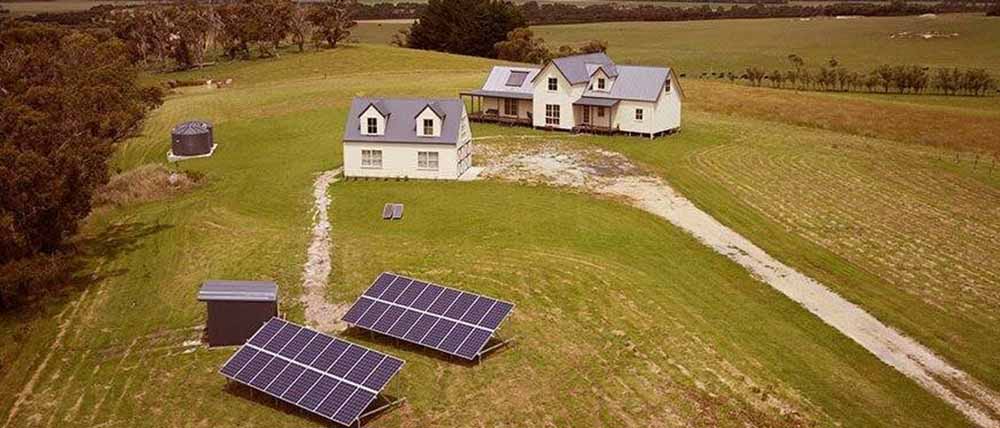When buying, building or renovating a house, it pays to make your home energy efficient. Here’s how to save money and the environment by making smart choices on energy essentials in your home.

How the sun produces solar power
Solar power converts light from the sun into energy. This can then be used to power your home or business, stored in a battery, or fed back into the grid.
To produce solar power, you’ll need to buy solar panels and an inverter to work with your switchboard and connect to the grid.
You can also buy a battery to store the excess power you generate.
The components of solar

Why some solar systems have a battery
Batteries have many benefits. With a battery you can:
- store excess energy, generated during the day, for use at night
- buy grid power at off-peak times
- sell stored power back to the grid for credits on your electricity bill.
Grid vs off-grid systems
There are two kinds of solar set ups — one that connects to the grid and one that’s off-grid.

Off-grid home in Foster installed by RACV
Check if your roof is ready for solar panels
Solar tips and advice
Rebates and finance options
Frequently asked questions
This depends on the size of your house, your energy consumption, and the quality of the system.
When it comes to solar, you get what you pay for. Basic solar systems can range from as little as $4,000 after all the rebates to tens of thousands of dollars for high-specification systems.
High-spec systems will produce more power from the same number of panels and last much longer than cheaper ones, meaning you can save for years and years into the future.
The average starting price for a 6.6kw system on a single storey house is around $5,000-$7,000, after rebates.
Did this answer your question?
Thank you for your feedback
Thank you for your feedback
The orientation of your solar panels will make a difference to the amount of electricity produced.
In Australia, the best position for solar panels to face is north – but don’t stress if this isn't possible on your roof. It’s all about positioning solar panels where they’ll get the maximum daily sun exposure. East- or west-facing solar panels can still be highly effective - particularly if you use more electricity in the morning and late afternoon, when the sun will hit those panels.
Our solar experts will find the best location for your panels based on your property.
Did this answer your question?
Thank you for your feedback
Thank you for your feedback
A battery will store any excess electricity generated by your solar panels. Later this stored electricity can be used when sun exposure is low, like cloudy days or at night. It can also provide emergency backup power during a grid outage.
The length a battery can power your home depends on the type of unit. As a guide, a typical larger battery will hold 50 to 75% of an average homes’ daily electricity usage.
If you don’t have a battery, you may need to reconnect to the main grid when your solar energy is low. This means you’ll be charged for power from your electricity retailer. Whilst you may earn by selling your excess electricity, the cost to reconnect to the grid can be generally higher than the credit you’ll get through a tariff.
Explore our battery storage systems to support your solar panels.
Did this answer your question?
Thank you for your feedback
Thank you for your feedback
Yes, solar panels still work on rainy or cloudy days. There is just less solar power produced on these days, as there are fewer particles of light available to create a high flow of electricity.
Some solar panels perform better in low light conditions. While the power output is reduced, you are still saving money whenever power is being generated by your solar system.
Solar panels won’t generate electricity at night because there’s no sunlight. But if you have solar power stored in a battery, you can use that electricity overnight. If you don’t have a battery, at night your house simply draws power from the traditional power grid.
Did this answer your question?
Thank you for your feedback
Thank you for your feedback
Most solar systems won’t work in the event of a power outage. This is required by law to protect line workers and property from danger when electricity is sent back to the grid from any rooftop solar generators.
In most cases, only systems with batteries capable of providing emergency power backup can operate in a blackout. Not all battery systems have blackout power protection, so check your type of system and its capabilities.
To speak with the team on how to be completely protected from blackouts, call 1300 447 765.
Did this answer your question?
Thank you for your feedback
Thank you for your feedback
Solar products we offer
^ Exclusions apply. Offer applies to eligible solar or battery systems sold with a home EV charger from RACV Solar until 30 April 2025. The $750 discount is valid for solar or battery systems that are 6.6kW or larger for residential homes only and will apply off the total value of the system when purchased with a MyEnergi Zappi EV charger or Tesla Gen 3 Wall Connector EV charger. Not valid in conjunction with any other offers or promotions.
**3.99% p.a. and 8.40% p.a. comp. rate is based on a $30,000 loan for 5-year loan period. See the comparison rate warning on www.plenti.com.au. All applications for credit are subject to approval. Terms, conditions, fees and charges apply. Credit provided by Plenti Finance Pty Limited ACN 636 759 861 (supported by its servicer, Plenti RE Limited ACN 166 646 635) or Perpetual Corporate Trust Limited ACN 000 341 533, Australian Credit Licence number 392673 (as custodian).




